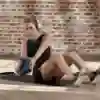Table tennis always looks like a flurry of activity to the spectator. With only a nine-foot table between them, players look like they are moving their arms at a million miles an hour.
While the quick hands and nimble wrists create the magic, the truth is that table tennis is more dependent on the legs.
“For me, table tennis is played with the legs,” says Sathiyan Gnanasekaran, India’s top-ranked male paddler, who plays for Dabang Delhi in the Ultimate Table Tennis league. “The hands only co-ordinate to get a good feel of the ball. Maybe when you are starting out, you need that. But at the top level, your baseline game is really tested. You have to have good footwork.”
Ranked outside the world top 100 in 2017, the 26-year-old became the first Indian to break into the top 30 earlier this year and peaked at a career-high of 24 in May 2019.
“Many Indians should be working on their footwork. In fact, I improved my footwork a lot in the last few years, and that has made the difference,” adds, Sathiyan.
Leg power and centre of gravity
Strong legs and good footwork form the foundation of table tennis. Although paddlers move about in smaller spaces than other racquet sports, they need power from the legs to help them lunge into position, strike and retract to a neutral stance. And all of it happens in a matter of a few explosive seconds.
But if you are hoping for long, lean legs, look elsewhere. Table tennis players pride themselves on big, muscled upper legs. That gives them the stability, balance and power.
“A lot of times, people think we are using the shoulder or upper body for a shot, but all that power is being generated through the legs,” says Achanta Sharath Kamal, who represents Chennai Lions in Ultimate Table Tennis.
The reason why 37-year-old Sharath Kamal is still able to compete is because of his acute focus on fitness. He was one of the first table tennis players in the country who was an ‘athlete’ and has paved the way for the coming generations. This despite standing much taller than his Asian counterparts at six feet two inches.
“It is harder for me because I’m taller,” says Sharath Kamal. “I have the reach, but I need strength in my legs. I have to bend further to keep a low centre of gravity and maintain my balance.”
Paddlers have to stay squatted for most parts of the match, which puts a lot of stress on the glute muscles and hamstrings. They move laterally or up-and-down the court in that position, and have to make sure to not lose that intensity for the duration of the match, which could stretch for up to an hour.
“The biggest muscles are the glutes and thighs,” adds Sathiyan. “When you can access that and use that power from the legs, you can hit the ball really heavy (Meaning, greater revolutions per second on the ball).”
HIIT and explosive strength
Sathiyan and youngster Harmeet Desai admit that for a lot of Indians growing up, the extent of fitness in table tennis was running and a few push-ups.
“Till I was 16, I used to get up at 5:30 in the morning and run for an hour,” says Desai, who plays for Puneri Paltan. “That made up for 90% of my fitness training. It was only when I went to Europe and played in their professional leagues that I understood that there’s more to it. It is one of the fastest games in the world. You need to be explosive as well as light on your feet and very fast.”
One of the go-to methods is high-intensity interval training. It requires athletes to push past their anaerobic levels for a few seconds, before a short rest or performing the same movement at a lower intensity. While it is considered one of the best training methods, it also mimics the short bursts of energy players require during a table tennis match.
“You have to start from zero, explode at a very high pace,” says Sathiyan. “There is no time to gain momentum or build up pace. That kind of luxury is not there in table tennis. You don’t need a 100m sprint, but you need that 10m sprint, really fast. How fast you go out of your block is important.”
To build that power and strength in the legs, paddlers also rely on plyometrics and weighted lower body exercises.
Star jumps, box jumps, one-leg hops or jumping from side-to-side are some of the exercises included in their drills.
Meanwhile, weight training is adjusted according to the playing season. Lighter weights with more repetitions are preferred while tournaments are on-going, while heavier weights for squats or lunges are used in the off-season, or whenever they have a three-week to a month’s break between tournaments.
Table tennis might be a game played with hands, but legs are clearly the powerhouse.







